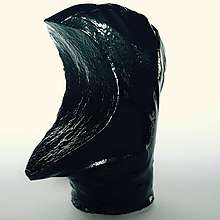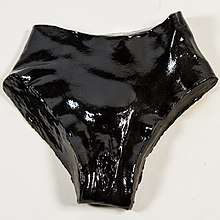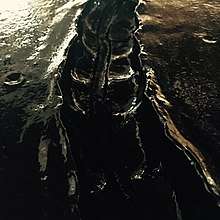Marina Sagona
Marina Sagona (born 1967) is an Italian and American artist living in New York City.[1] She works in a variety of visual media around the concepts of control and codependency, often collaborating with other artists. Sagona is the recipient of the 2017 Strategic 50 Award[2] and of the 2019 Domus Artist Residency in Galatina, Italy.[3]



Life and education
Sagona was born in Rome [4] and attended the Liceo Ginnasio Statale Virgilio and the Sapienza University of Rome. She first started her artistic career as an illustrator working in the publishing world. In Rome she worked as assistant to artist Mario Schifano, one of the most significant and pre-eminent artists of Italian post-modernism. In 1995, she moved to the United States and began to contribute regularly to The New Yorker[5][6] and The New York Times.[7][8] In 2006, Sagona wrote and illustrated the book No, Anna e il cibo,[9] based on her experience after her daughter was diagnosed with a rare form of infantile anorexia. Afterwards Sagona gradually abandoned illustration for visual art. In 2014, she co-curated the show Dante Ferretti: Design and Construction for the Cinema at MoMA.[10]
Works
Self-Portrait, 2019
The video Self-Portrait (25:55 minutes) is a group of six interviews with six different women, including the artist, on six different topics. The first two interviews are colored in green, the third and fourth in white and the fifth and sixth in red. The six protagonists are: Judith Thurman (writer), Ingrid Rossellini (professor), Anna Siciliano (student), Marina Sagona (artist), Giovanna Calvino (author) and Anna Funder (writer). Judith Thurman talks about her parents and her childhood; Ingrid Rossellini talks about moving to New York city in the early eighties and political correctness; Anna Siciliano talks about the difference between American and Italian upbringing and also about anxiety; Marina Sagona talks about codependence and abandonment; Giovanna Calvino talks about depression and approval; Anna Funder talks about chemical identity. Through the words of these women, the self-portrait of the artist takes shape.[11]
The Prisoner, 2018
Sagona's The Prisoner is a cycle about co-dependence exhibited at the Fondaco Gallery, Rome, in connection with the 13th edition of the Rome Film Fest. As Claire Messud writes in the essay on this work, “Codependent love entails a passionate devotion to the unrequited, a desire for self-abnegation. Its ironies are rife: how readily we give of ourselves, believing that eventually our sacrifices will be recognized; how thoroughly we put the needs and desires of the troubled before our own; how proud we are of our ability to stand in the heart of the flames, and burn”.[12]
Eden, 2017
Eden is an installation based on the idea of the world's regression to a new State of Nature. Sagona used found objects, collected over the years, that she disassembled, recomposed, and then covered in golden paint, creating a Midas' garden of hybrids and modern relics.[13]
The Comedy of Women, 2016
The Comedy of Women is a series of imaginary portraits of the women Dante Alighieri encounters during his journey in the afterlife. The series of portraits was accompanied by an introduction by Colum McCann and narrative portraits written by authors Judith Thurman, Jhumpa Lahiri, Alice Sebold, Claire Messud and Anna Funder.[14]
Other work
Other work includes Amour Fou,[15] a catalogue of carnal love, At Home, a work on "Intimacy and claustrophobia of domestic life, using the physical space of my home"[16] and Punti Fermi, an investigation into female role models.[17]
References
- "Marina Sagona". EdizioniEl. EdizioniEl. Retrieved 22 October 2017.
- "Marina's 47 Years 1 Month 3 Days". Strategic50. Retrieved 23 October 2017.
- "Domus 2019 — DOMUS artist residency". Domus Artist Residency. Retrieved 17 May 2020.
- "Number 9 The Fiction Issue" (PDF). Five Dials. United Kingdom: Hamish Hamilton. Retrieved 22 October 2017.
- "The New Yorker". The New Yorker. New York, USA: Condé Nast. 15 May 2000. p. 28. Retrieved 22 October 2017.
- "The New Yorker". The New Yorker. New York, USA: Condé Nast. 2 April 2001. p. 21. Retrieved 22 October 2017.
- "The New York Times Book Review". The New York Times Book Review. New York, USA. 2 February 1997. p. 1. Retrieved 22 October 2017.
- "The New York Times Magazine". The New York Times Magazine. New York, USA. May 9, 1989. p. 1. Retrieved 22 October 2017.
- Sagona, Marina (2006). No, Anna e il cibo. Rome, Italy: Orecchio Acerbo. ISBN 8889025336.
- "Dante Ferretti: Design and Construction for the Cinema". MoMA. MoMA. September 2013. Retrieved 22 October 2017.
Organized by Ron Magliozzi, Associate Curator, and Jytte Jensen, Curator, Department of Film, The Museum of Modern Art; with Antonio Monda, author and professor, New York University; and Marina Sagona, artist.
- "Marina Sagona". Macro Asilo 7. Rome, Italy: Museo D’Arte Contemporanea Di Roma. 1 April 2019. p. 53.
- "Festa del Cinema di Roma". Festa del Cinema di Roma. Rome, Italy: Varigrafica Alto Lazio. 18 October 2018. p. 198.
- "Marina Sagona. Eden". Rome Art Week. Rome Art Week. 2016. Retrieved 22 October 2017.
Through this work, Marina Sagona puts the emphasis on the inversion of values that characterizes the contemporary world: values such as love, friendship, compassion are emptied of their positive role, marginalized to give way to a new feeling. The world has catapulted into a new "state of nature" in which applies the law of the strongest, and establishes a system of absolute freedom that finally becomes anarchy and a state of war.
- Francesca Cigola (2016). "Sagona. The Comedy of Women". Artwell Guide. Artwell Guide. Retrieved 22 October 2017.
Ierimonti Gallery is pleased to present "Sagona - The Comedy of Women", a project that intertwines literature and art and draws inspiration from the most influential masterpiece of Italian literature- Dante Alighieri's Divine Comedy. Marina Sagona's imaginary portraits capture the idiosyncrasies and the archetypical power of Hell, Purgatory and Paradise's female residents. In turn, authors Judith Thurman, Jhumpa Lahiri, Alice Sebold, Claire Messud and Anna Funder respond to Sagona's visualizations of Dante's text by creating their own narrative portraits of the women.
- Sagona, Marina (2011). Amour fou. Italic arte. ISBN 8896506417.
- Sagona, Marina; Zanganeh, Lila Azam; Calvino, Giovanna; Monda, Antonio; Rhodes-Pitts, Sharifa (2008). At Home. Rome, Italy: Orecchio Acerbo. ISBN 9788889025734.
- Sagona, Marina (2007). Punti Furmi. Palermo, Italy: Associazione Nuvole.